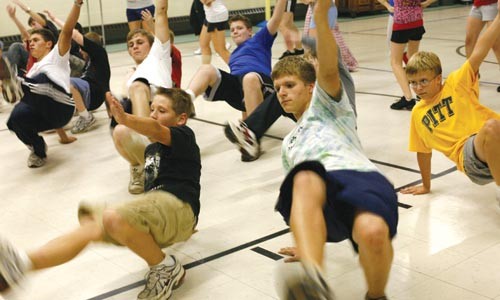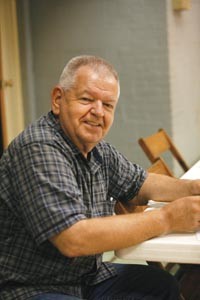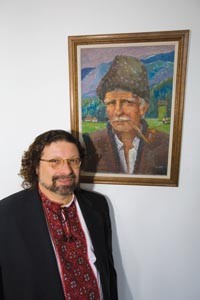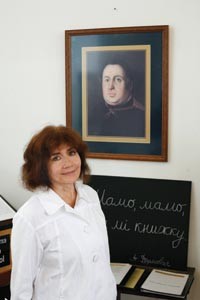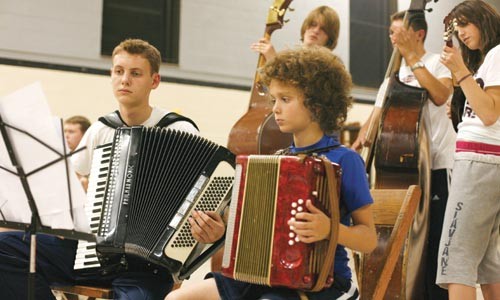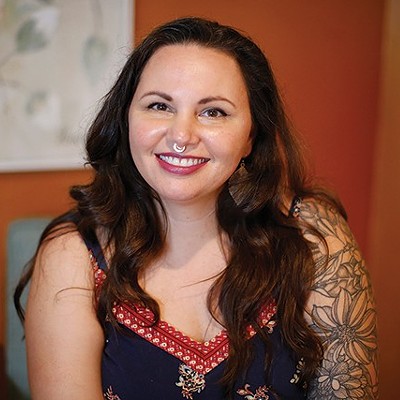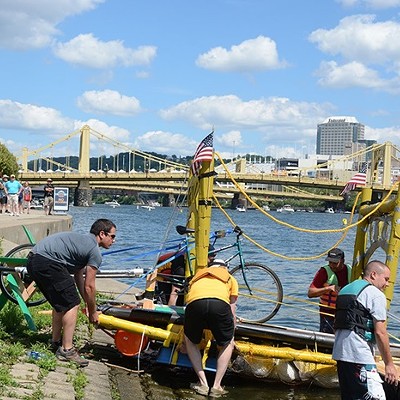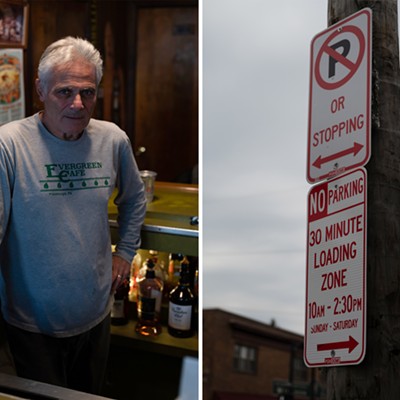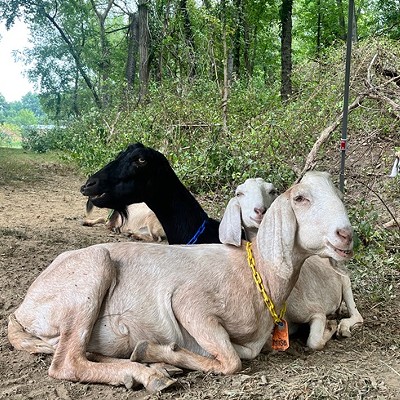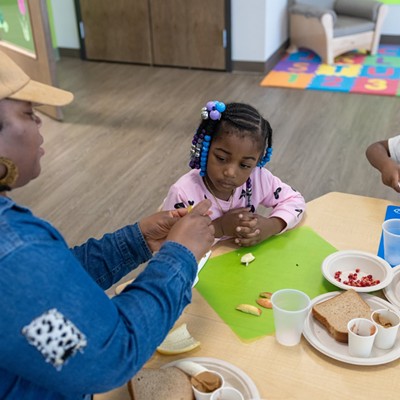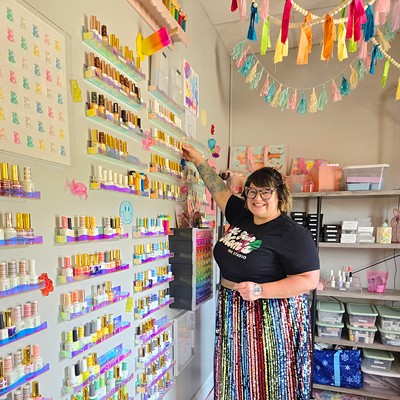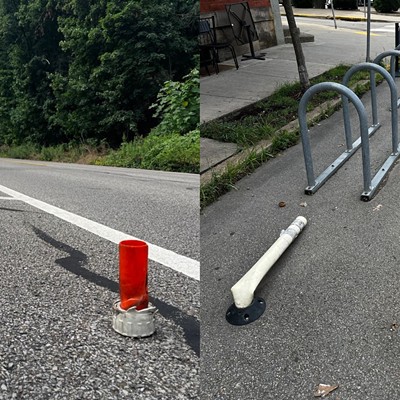Of all of the ethnic groups that have settled in Pittsburgh, few are as mysterious as the Carpatho-Rusyns. So convoluted is their history, so mysterious their origins, that many Rusyns are mysteries even to themselves. No one even knows precisely how many Rusyns there are -- though some estimate their numbers at 2 million -- in part because Rusyn identity has been suppressed for centuries. It's not just possible to work alongside a Rusyn without knowing it; it's possible for the Rusyn not to know it, either.
What we can say is this: Carpatho-Rusyns -- also known as Ruthenians, Rusins, Rusnaks and Ruthenes -- hail from a region that includes portions of eastern Slovakia, southern Poland, and the foothills of the Carpathian Mountains in western Ukraine. If you were to look up a blurb about them in an encyclopedia (and a blurb is all you're likely to find), you'd learn they are largely rural people, speak a Slavic tongue, and write in the Cyrillic alphabet common to Russians and other Slavs.
And for decades, Western Pennsylvania has been a second homeland for this people without a home. Pittsburgh's own Andy Warhol is without question the world's most famous Rusyn-American. Former Pennsylvania governor Tom Ridge, a Munhall native, is Rusyn as well.
But the list of Rusyn celebrities quickly grows thin. Tom Selleck. Sandra Dee. The guy who created the Ren and Stimpy cartoon. And modest ambitions may be part of the Rusyn character. Consider a few versus from "I Am Rusyn," a famous hymn by 19th-century Rusyn patriot Aleksander Duchnovič:
My father and mother were Rusyn,
As are all my relatives,
My brothers and sisters are Rusyns,
And my large group of friends.
And it goes on like that. Rusyns are like the Pittsburghers of Europe: nice neighbors, hard workers ... but unaccustomed to making big claims for themselves.
So it falls to me, a non-Rusyn, to make a big claim for them. Which is this:
At a time when the world is seething with ethnic unrest, when American politics is seized with immigration fears, and even an obscure people like the South Ossetians can nearly touch off another cold war -- at a time like that, if humanity hopes to survive, it may have to look to the Carpatho-Rusyns.
The first time I saw Rusyn identity politics firsthand, it was at the Pittsburgh Folk Festival. Amid the bustle of patrons looking for haluski in the David L. Lawrence Convention Center, I saw an intense-looking guy in Eastern European peasant dress and a goatee standing in front of a booth, having an obviously charged discussion with a festival visitor.
"Who gets into an argument at a folk festival?" I wondered.
The answer was Dean Poloka. But you can't blame him: He was arguing with somebody who insisted he didn't exist.
Poloka says people of Eastern European descent sometimes contend that there are no such things as Rusyns -- that "If you came from Slovakia, you're Slovakian."
Rusyns "never had a country of our own," Poloka says. "So we try to tell people that nationality and ethnicity aren't the same thing. And that we just want to promote our heritage, speak our language, and be who we are, without being harassed."
Like the Basques of Spain, or Jews for much of their history, Rusyns are one of history's stepchildren: one of those countless -- and usually uncounted -- peoples whose role on the global stage has largely consisted of bit parts written by someone else. There are many such people: Ethnographers have compiled a list of several thousand ethnic groups across the world, but only 200 countries on the map.
Carpatho-Rusyn history is too convoluted to explore fully. (Plus, the harder I try, the more certain I am to touch off headache-inducing letters from one side or the other.) Suffice it to say that the Rusyn homeland is, as Poloka says, "a very strategic area, at the crossroads between east and west. So a lot of people started vying for it, trying to make it their own."
According to the Encyclopedia of Rusyn History and Culture, early maps described much of the Rusyn homeland as terra nullius ("no-man's land") or terra indagines ("the land in-between"). Which sums things up. Russyns first began settling in Eastern Europe around 500 or 600 AD, and since then, their territory has been claimed by groups including the Magyars of Hungary, the Poles, the Austro-Hungarian Empire, the Nazis, the Soviet Union, and Czechoslovakia.
For 1,500 years, national borders have extended and receded across the Rusyn homeland, like waves on the beach. But the Rusyns, a largely agricultural folk, have remained. A common joke among Rusyns is that their family has lived in five different countries -- without moving once.
Unlike some other stateless people, Rusyns have never been victims of a genocide (perhaps partly because eradicating a people requires recognizing their existence). But large numbers have been displaced, and numerous efforts have been made to repress their ethnicity. The Hungarians tried to "Magyarize" them, for example, while the Soviets tried to convince them they were Ukrainian. Rusyns have had only fleeting shots at self-determination. One 1939 effort to create a standalone country lasted a single day: The Hungarians invaded (again), and the government was run by ethnic Ukrainians anyway.
Over time, some Rusyns forgot that they were Rusyn at all. Rusyn identity was so muddled that originally, even the booth that local Rusyns used at folk-festivals described the people as "Caraptho-Russian." Russians are a different group entirely, notes Jack Poloka, Dean's father and a passionate Rusyn-American: "We just didn't know any better."
The once-and-future heart of the Rusyn-American community is St. John the Baptist, a yellow-brick Greek Catholic church not far from Homestead's Carnegie Library. It's been stripped of its stained glass, and Heaven is obscured by a distinctly uncelestial drop ceiling. But as Mary Ann Sivak says, St. John's "was the headquarters for the Rusyn people in America." And the hope is that it can be again, once it is renovated into a cultural center by the Carpatho-Rusyn Society, where Sivak serves as vice-president.
No one can say how many Rusyn immigrants came to America: Early records tracked immigration by country of origin rather than ethnicity. But in the new world as in the old, they were little more than pawns in someone else's game.
Histories suggest that as early as 1877, mining and steel companies were recruiting Rusyns to work as strike-breakers in America. Rusyns were soon drawn to the mills of Pittsburgh, and in 1903, St. John the Baptist became the first American church built expressly for the Rusyns and their faith, Greek Catholicism.
Also known as Byzantine Catholicism, Greek Catholicism is the kind of hodgepodge faith you'd expect the Rusyns to have. It looks like an orthodox faith: The services and religious calendars are similar -- Christmas takes place in January -- and churches sport a cross with three bars, and celebrate Easter with pisanki, intricately decorated eggs. But as their name implies, Greek Catholics are under the Vatican's jurisdiction. In exchange for pledging fealty to the pope in the 1600s, Greek Catholics were permitted to retain their own practices -- including allowing priests to marry.
But they had a hard go of it in America. American workers already distrusted the "scabs," and as the history Byzantine-Rite Rusinsin Carpatho-Ruthenia and America says, to American Catholics the newcomers "had strange customs and were unable to speak the English language."
In 1929, the Pope issued an edict that, among other things, required all priests to be celibate. Many Rusyns denounced the edict as a papal power play, and Western Pennsylvania was a battleground for disputes over celibacy and church property. A Rankin priest was excommunicated, and in 1936 a court order was needed to oust a priest from St. John's itself. Some disgruntled Rusyns started their own churches; others joined the Russian Orthodox and other eastern faiths. The rituals were similar, and over time, some parishioners got the idea they'd been Russian all along.
Sivak, who grew up in Czechoslovakia, says her grandfather had a rueful summary of Rusyn history: "First they took our God, then they took our land, and then they took our identity." Many Rusyn immigrants surrendered each of those things on their own. "For immigrants, the goal was just to make a living, and not stick out your head," Sivak says. "The second generation is the melting pot -- being Rusyn is the past, you're an American now. It's the third generation that really begins to take an interest."
Which means that Americans with Rusyn blood are only just learning the fact -- sometimes by discovering a triple-barred cross in the attic.
It's for such people that the Carpatho-Rusyn Society was formed in 1994. It later acquired St. John's after the Greek Catholic church vacated it (not because of a schism, but to find better parking down the road). For now, the center is somewhat bare, sporting donated funerary and religious items along with other scattered artifacts. But the society has a $2.7 million plan to turn it into a cultural museum and genealogical center.
In the meantime, society cofounder John Righetti has led tours back to the Rusyn parts of Europe, journeys that allow Rusyns like Bettianne Sekerak to connect with a heritage they didn't necessarily know they had lost.
Sekerak hails from suburban Youngstown, Ohio, but she and her husband, a retired electrician, come to Munhall to help with the center. "When I was a child, I knew I was Rusyn, but I would say I was Slovak, to make it easy," she says. But having visited Slovakia with 30 others earlier this year, "I will not deny my heritage now."
When she visited Slovakia, she says, she felt almost as if she had been born there. In a Rusyn village, she says, "The buildings are in buttery yellows, sherbets, blues and pinks. They are like what we see in fairytale books -- and everyone has flowers.
"Everything is new for us, now that we're allowed to exist," she adds.
The fall of Communism, in fact, helps explain the growth of Rusyn awareness. Since its founding, the CRS has acquired 10 chapters across the country and nearly 2,000 active members, most of whom live in the Pittsburgh region.
But even getting this far wasn't easy, says Righetti, a spokesman for Butler Hospital who grew up in an Italian-Rusyn household and still wears a three-bar cross on a necklace. When the first CRS meeting was held at the University of Pittsburgh, he says, he told Pitt it should have security on hand, just in case. "To be Rusyn is political," Righetti says, "even though our only sin is our geography."
The Rusyns lack territory, or an army to defend it. What they do have is culture.
Located in a White Oak strip mall, WEDO 810 AM seems an unlikely outpost. But the "Station of Nations" has carried a weekly broadcast of Rusyn folk music for more than a decade. Jack and Dean Poloka do a half-hour broadcast every Sunday ... even though finding the music hasn't always been easy.
"Up until recently, it was hard to get materials," Jack Poloka says. With the Communists suppressing expressions of Rusyn culture, "We'd only get occasional cassettes." But now the Polokas' record collection numbers some 300 CDs.
And they need it, because the Rusyns are a fragmented people. There are Lemko Rusyns, who live in Poland, along with those living in Ukraine, Slovakia and elsewhere. And "[T]he music is different from one region to the other," Poloka says. Sitting in the studio during a broadcast , Poloka demonstrates by tapping out rhythms in 3/4 time, 6/8 time, 13/16 -- stopping intermittently to notify listeners of events like an upcoming pilgrimage in Uniontown. (Uniontown is home to Mount St. Macrina, a Byzantine Catholic convent.) "There will be many liturgies, prayer and spiritual enrichments ... and great food, including their famous medovniki," Poloka tells his audience.
WEDO's signal is not strong, but this broadcast will be posted online, so Jack Poloka's gentle voice will reach all the way to the Rusyn homeland itself, where Rusyns can download it and know they are not forgotten.
Jack Poloka is even better known as the cofounder of Slavjane (pronounced "slahv-YAWN-ee"). Founded in 1961, Slavjane performs Rusyn folk music and dance. It's not easy to distinguish Rusyn dances from other Eastern European steps, but what separates Slavjane is expertise: Half an hour after I saw Poloka defending his own existence at the Pittsburgh Folk Festival, Slavjane took the stage and more or less blew everyone else off it, executing athletic jumps and synchronized movements few other groups seemed capable of.
Slavjane has become a sort of farm team for Duquesne University's famed Tamburitzans. At one time, Jack Poloka says, a quarter of the Tamburitzan's three dozen performers were Slavjane alumni. "And that's with the whole of North America to choose from!" he boasts.
So it's little wonder the Polokas sometimes bridle at slights to their heritage.
Take Out of this Furnace, the celebrated Thomas Bell novel of immigrants in Pittsburgh's steel industry. Everyone thinks it's about Slovaks, the Polokas say, but most of the book concerns the family of Mike Dobrejcak, who hails from a "Rusnak" village.
And the Russian Nationality Room at Pitt? The Polokas say it should be the Rusyn Nationality Room, since it uses Rusyn motifs.
The importance of such debates may be lost on outsiders. One trait Rusyns take pride in is their history of living peacefully with other cultures, so blurring of cultural boundaries is inevitable. (Pitt's nationality room, for example, uses folk-art motifs common in much of the region. Its designer, Andrey Avinoff, was born in the Ukraine.)
But local Rusyns have always had to fight to get their foot in the door. Jack Poloka recalls that in the early years, other nationalities tried to keep him out of folk festivals, claiming they represented the Rusyns.
And Rusyns themselves sometimes struggle to connect with their heritage. The Heinz History Center has long featured an exhibit of Rusyn burial traditions, but the center's director, Andy Masich, confesses to being cut off from his own Rusyn history.
The parents of Masich's father emigrated in 1903 from the Presov region, a Rusyn nexus in Slovakia. But while his father could speak the Rusyn language, "he called it 'Slavish,'" Masich recalls. "And I never heard anyone in my family talk about Rusyns."
Masich's father had been cast out of the family for marrying a Scots-Irish woman, who refused to raise her children Greek Catholic. Masich might never have known his father's ethnicity at all, except that his uncle, a Greek Catholic priest, came to his father's funeral -- with his collar covered up.
Because of their history through the fall of Communism, says Masich, "I think Rusyns have been slow to recognize who they are." Even today, he says, while he has "an affinity for things Rusyn, there's enough separation that it's hard to regain some of those traditions."
Such stories are common, but Rusyn advocates like John Righetti have tried to make a virtue out of the Rusyns' rootlessness.
Democratic Presidential candidate Howard Dean may think he invented the "meet-up," but the Rusyns, Righetti says, got there first. Rusyn groups have tried to reestablish a cherished Rusyn tradition known as the vatra -- a bonfire in which Rusyns gather around the fire to share food, music and each other's company. It's a bit like a medieval flash mob. Similarly, Righetti says, Rusyn youth groups, and the WEDO Webcast, show the Rusyn diaspora reaching out. "How do you keep a community alive when it's not connected geographically?" Righetti asks. "You do it electronically."
In fact, Righetti says, the Rusyns are "probably the world's first virtual ethnic community."
Not surprisingly, Rusyns brag most of all about Andy Warhol. The Warholas originally hail from the village of Medzilaborce; one of the first Rusyn cultural organizations to arise after the fall of Communism was that town's Andy Warhol Society. And for a decade, The Andy Warhol Museum on the North Side celebrated "Rusyn Day," in which patrons witnessed Greek Catholic ceremonies and engaged in cultural activities like egg painting.
"You can see Rusyn culture all though Warhol's work," Righetti says. The artist's famous paintings of Marilyn Monroe, Righetti says, are merely 20th-century updates of Greek Catholic icons. Rusyns even interpret Warhol's famous assertion "I come from nowhere" in Rusyn terms: It reflects, they say, the lament of a people without a place on the map.
As with many of Warhol's gnomic utterances, though, others read the remark differently. Pittsburghers may see it as a dig at his hometown; art critics note Warhol revealed as little of himself as possible.
Warhol's ethnic background certainly helped shape his art, agrees Tom Sokolowski, the Warhol's director. For a working-class kid in Pittsburgh, going to a church service "with music and incense and priests wearing dazzling robes -- it was like what rich people did." But, he adds, "Any great person is never represented by just one thing. He was influenced by his culture, sure. But also by being gay, and by growing up poor."
In any case, the Warhol has ceased holding Rusyn Day. Righetti says the event "lived out its life cycle." Sokolowski says it often caused some cognitive dissonance. "The first year we had 1,000 people," Sokolowski says, "but a lot of them didn't like the pictures in the galleries. And when you say, 'What about bringing in a [Rusyn] composer who is doing something really new?' people don't want to hear that."
It's a natural impulse -- to want to preserve a ritual as if it were a family heirloom. But doing so is akin to embalming your own identity, burying it in native costume. "I'm not asking anyone to eschew traditional culture," Sokolowski says, but if that's all you focus on, "it becomes a 'you can't go home again' thing."
There is some truth to that. Jack Poloka ruefully notes that while "We're trying to keep alive our traditions," in the Rusyn homeland itself, "they're trying to be Western."
There are, in fact, concerns that increasing prosperity will do to the Rusyns what centuries of oppression could not: dilute their identity as a rural people. Younger Rusyns are leaving for the city, and on her own visit, Bettianne Sekerak noted a ritual previously unknown to Rusyns: the traffic jam.
Younger Rusyns especially try to take such changes in stride. Take Maria Silvestri, a Monroeville native who is an anomaly even among an anomalous people. "I could count on one hand the number of Rusyn activists who are my age," says the 23-year-old, who pairs her interest with Rusyn culture with a passion for leftist politics. "Most people who are active are my mother's age -- nostalgic for a village life they've never had."
Silvestri -- a graduate student studying how groups like the Rusyns are represented in museums -- helped create a Rusyn youth newsletter and Web site called "Rusyn Outpost" (http://rusynoutpost.ning.com), which billed itself as "Not your Baba's Rusyn Outpost." The newsletter, now defunct, wrestled with questions of how to make Rusyn identity cool, rather than something your parents force you to do.
Creating a pop culture is "crucial if Rusyns want to ensure that their young ... do not fall victim to the threat of assimilation," one 2003 article asserts. But the creator of Pop Art is a distinctly unlikely ethnic spokesman, notes the piece's author, Brian Pozun: "Warhol's legacy includes homosexuality and drugs [while the church-dominated] Rusyn culture is fantastically asexual. ... Warhol was obsessed with fame [while] the Rusyns are one of the least-known nations in Europe."
Silvestri and her circle have dabbled at creating a Rusyn pop culture of their own. They devised, for example, a Rusyn version of the oval-shaped destination bumper-sticker; like the "OBX" acronym sported by tourists who've visited the Outer Banks. The Rusyn version says simply "Nowhere" -- a Warhol reference as well as a timely joke in an era of $4 gas and "staycations." Silvestri also designed a T-shirt answer to the Jewish American Princess -- the Carpatho-Rusyn American Princess, whose acronym, of course, is CRAP.
Part of what makes such efforts unusual is that based on my interviews, there's no such a thing as a Rusyn joke, in the way that there are, say, Polish jokes. It's not that Rusyns are humorless. The problem, once again, is that hardly anyone knows who Rusyns are ... and nothing ruins a joke like having to explain it.
Silvestri credits older Rusyns with starting to provide that explanation. The Polokas "did Rusyn stuff before anyone else did: They fought the battles. And Slavjane is a really great introduction to Rusyn culture." Silvestri herself participated in the group, and says the Polokas gave it a sense of mission. "If you look bad, it's like, 'The Rusyns don't have their shit together.' So you work twice as hard, because we could have disappeared off the map entirely."
That seems less likely since the fall of Communism. The Slovak government now embraces and funds Rusyn cultural expressions. As this issue goes to press, Silvestri is in Slovakia, working with a Rusyn cultural museum. And she thinks it's safe for Rusyns to being innovating.
"I don't want to chuck all that traditional stuff," she says. "But there's Rusyn punk music now. We still know the traditions -- but that doesn't mean you can't adapt them."
But if the Rusyns, already denied a country, change their traditions, what do they have left? Righetti and Silvestri boast that their past has bequeathed a postmodern notion of identity, one in which there is no essential "national character."
"The Rusyn movement is international, and decentralized," Silvestri says. "It's anarchic, and that's what I like about it.
"You can be nationalistic without being a nation," she adds. "Is Steelers Nation a country?"
That, says Robert Hayden, "is a very healthy, refreshing attitude."
An expert on nationalism and director of the University of Pittsburgh's Center for Russian and East European Studies, Hayden says that, ordinarily, "nationalist issues are pretty intractable. When I first came to Pittsburgh in 1986, Serbs and Croats got along beautifully. There were people who were members of both Croatian and Serbian fraternal groups. Then you get the demands for independent republics, which led to a lot of unpleasant stuff."
When people begin identifying their culture too strongly with something fixed -- as something that can be inherited, or planted in a particular soil -- "the question of identity gets really nasty," Hayden says.
Hayden doubts any blood will be shed for a Rusyn state. They "are distributed too widely to effectively proclaim a homeland," he says. Which is just as well: "States tend to rigidify, and to promote a fixed identity. But identity is inherently fluid, changing constantly."
While nostalgia for 19th-century peasant life is understandable, says Hayden, "The Rusyn identity is whatever people who regard themselves as Rusyns do. And those things change all the time. Look at all the changes in American cultural practices: A lot of the things we take for granted didn't exist in the 1950s. Yogurt used to be exotic."
Then again, perhaps it's precisely because American culture seems so flimsy that many people -- Rusyn and otherwise -- take such an interest in genealogy. Maybe that helps explain why Bettianne Sekerak says she felt "homesick for a place where you weren't even born."
For Rusyns, who may be discovering their roots after decades of being told family histories that didn't add up, such feelings may be especially poignant. But thanks to trends like globalization, the Internet and the rise of stateless terrorism, we're all living in a world where borders are permeable. "Within 20 or 30 years, people's identification with the nation-state is going to disappear," Righetti predicts. And who better to usher in the new era than "a people without borders" like the Rusyns?
Rusyn historian Paul Robert Magosci has written that "each person has the right to claim whatever ethnic identity he or she wishes, regardless [of whether] the claim has any relationship to objective ... criteria, such as geographical origin, spoken language or customs." Even in the American melting-pot, that may be hard to swallow. Just look at all the efforts to make English the "national language." But it seems a particularly Rusyn sentiment (assuming such a thing can be said to exist). It may explain why Rusyns have "always lived peacefully in multicultural, multiethnic groups," as Silvestri says. Probably the world would be a quieter place if more people lived that way now.
Even the Rusyns' mix-and-match Greek Catholic faith could play a part. The very thing that made it an anomaly for centuries -- its strange hybrid of east and west -- could make it a model for religious tolerance in the future.
After all, the Roman Catholic Church and the Eastern Orthodox faiths split nearly 1,000 years ago, in a "Great Schism" that Pope Benedict called "a scandal to the world" in 2006. But Greek Catholics have shown reconciliation is possible; as the history Byzantine Rite Rusins hopefully proclaims, Rusyns could "form a bridge between these two Christian religions, and ... be the mechanism for Christian re-unity."
Of course, none of this would be easy. Rusyns still aren't recognized as a distinct people in the Ukraine, and Righetti warns that "Ukraine could be creating trouble for themselves." There is a nascent nationalist movement in the Ukraine, and some Rusyns "are saying to Russia, 'Maybe you can help us.'" A similar dynamic helped trigger the trouble in South Ossetia, where Russia used a minority group's nationalist aspirations to advance its own agenda.
But when European Rusyns ask, "Should we have a Rusyn state?" Righetti says his response is, "Don't waste your time." Even Dean Poloka -- who describes himself as a "hard-line Rusyn nationalist" -- prefers not to have an actual nation: "We're better off not having a country. You don't have to worry about politics."
In other words, if the Rusyns were looking for a national anthem, they could do worse than a song like John Lennon's "Imagine," which invites us to "Imagine there's no countries ..."
But of course, the Rusyns aren't the sort of people to deny themselves an anthem, just because they don't have a country. For more than 100 years, they've celebrate their identity with the song "Podkarpatskije Rusiny, ostavte hlubokij son."
Or, loosely translated, "Rusyns, Arise From Your Deep Slumber."


